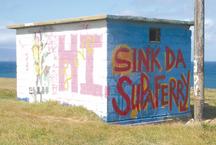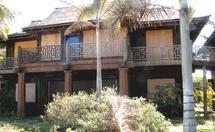Quickie updates on three Maui issues
by Rob ParsonsNovember 29, 2007
 |
 |
 |
Tough building
photo: Rob Parsons.
Since our modern era caters to shorter attention spans, here's a pre-holiday-season update of late-breaking developments (oops, sorry to use that word) on some key local issues:
Wailea 670
Don't call it Honua'ula, no matter how the offshore developers may want to package this mega-development. That's what Uncle Ed Lindsey of Maui Cultural Lands reminded the community a few months ago. Honua'ula was the name given to the entire region, stretching from Palauea to Keoneo'i'o, and from Ulupalakua to Kaho'olawe.
"Anyone rightfully using the name Honua'ula should honor our ancestors and protect our history and legacy at all costs," Lindsey, a long-time Maui Tomorrow board member, said. "A place calling itself Honua'ula should prominently showcase Hawaiian culture. It should respect, value and protect all parts of that culture in their natural state-the land forms, the plants and the remains of Hawaiian cultural sites."
Yet, review of revised cultural and botanical surveys was just one of several important points that the majority of County Council members punted away last week when Mike Molina's Land Use Committee finally passed Wailea 670's re-zoning request for 1,400 housing units and a private golf course.
Six County Council members agreed on about 30 conditions that developers would need to follow, but tough questions about water, traffic, clear titles, sewage treatment, affordable housing, best protection for traditional access, native plants and cultural sites were not fully answered. Indeed, any project requiring that many conditions to bring it closer to compliance with legal requirements and community needs may have been fatally flawed from the start.
Council members Michelle Anderson, Jo Anne Johnson and Riki Hokama may be expected to continue to ask tough questions as the full County Council debates the first and second reading of the bill, with more opportunities for public testimony. It seems Hokama, serving his fifth and final consecutive term as Lanai's council representative, has recently begun vocalizing his displeasure with off-island investors-in this case, Cargill, Shearson-Lehman, D.E. Shaw Group and others-planning Maui County's future.
Without rezoning, Wailea 670's international investors have approvals to build two golf courses and a park on their lands. Period. The Kihei-Makena community Plan is clear: the council does not owe the investors any entitlements unless the "necessary infrastructure and services are available."
New council members Gladys Baisa, Bill Medeiros and Mike Victorino may not fully understand that they have every right to demand more from large developments before signing off to a 20-year build-out plan. Councilmember Anderson continually called for more information to what she deemed an incomplete zoning application and a 20-year old Environmental Impact Statement (EIS). But Planning Department staff refuted this, and often looked more like developer's representatives than overseers of our zoning ordinances and community plans.
"It will be the demise of South Maui," a friend recently told me if Wailea 670 passes. I wonder if it may also be the demise of the council terms of those who vote to approve it. Of course, that would require people to show up on election day. Are you registered to vote?
Lingle's Super Folly
We have a new law permitting "large capacity ferry vessels" to operate while an EIS is being prepared. Woo-hoo! Can somebody give Governor Linda Lingle and our legislators a high-five?
State Attorney General Mark Bennett, under Lingle's command, crafted a state statute that "fixes" that inconvenient detail in our environmental laws calling for the $300 million Hawai'i Superferry Project to do their EIS before beginning inter-island ferry service. Maui's Judge Joseph Cardoza, who ruled in late August that the Superferry could not sail until they prepared an environmental study, had little choice but to lift his injunction in light of this "new law."
John Garibaldi, Superferry CEO, calls this a "new beginning" and plans to set sail between Oahu and Maui on Thursday, Dec. 6 with reduced rates. But wait: Aren't their tariffs set by the Public Utilities Commission? True, and they were fined by the PUC for jumping the gun with $5 fares back in August. Not that the amount of the fine would get in the way of their 350-foot, 40-knot vessel.
The unlikelihood of Superferry ever making money in Hawai'i was discussed in this space a few months ago ("Do the Math: So much about Hawai'i Superferry doesn't add up," Aug. 30, 2007). With rising oil prices, their diesel-guzzling engines (6,000 gallons per one-way trip from Oahu to Maui) will surely result in ever climbing fuel surcharges.
Garabaldi said his company needs both the Kauai and Maui routes to be economically successful. But no service date has been scheduled for Kauai, which is vying with Molokai for the moniker of "The Protest Isle."
Superferry officials claim they are conducting, "community outreach" on Kauai to smooth their return visit. But Kauai residents refute that, saying the company hasn't contacted them. Several organizations drafted and signed a letter to Superferry asking them to stay away until an EIS is completed.
So while the impediment of a clunky environmental law may have been overcome by Lingle, the ill-will persists, created by the top-down edict decreeing that the ferry will sail no matter what. It's no wonder the Superferry is listing, taking on water like the Canadian cruise ship that hit the Antarctic iceberg.
Whether Superferry's arrival at Kahului Harbor will be met with a red carpet or protest signs remains to be seen. Maybe there really are a number of people waiting to ride the ferry, seduced by promises of cheaper travel, complete with great views and cocktails. Just don't forget the Dramamine.
 |
 |
 |
photo: Rob Parsons
Montana Beach
Please don't call it Montana Beach, Baldwin Beach or Lime Kiln Beach. The proper Hawaiian place name is Kapuka'ulua. Get used to it.
The council's Policy Committee in executive session last week heard a proposal to settle lawsuits on the third lot of the long-disputed beachfront parcel near Paia on Maui's North shore. Acquiring the middle lot could help make sense of the County's previous acquisitions of the other two bookend lots.
That's the good news-public usage trumping privatization of our coastal resources.
But The Maui News also reported that the Mayor's Office is "studying how to demolish" the luxury home that was built on one of the lots. It further stated that "A staffer has been assigned to form a task force to devise a request for a proposal to remove the structure from the site that is intended to be a beach park."
A task force? Now, there's some outside the box thinking.
Pick me, pick me! Seriously: I'm qualified and know a lot about the house.
I spent much of last year as Mayor Alan Arakawa's Environmental Coordinator, garnering support for the idea of adapting the existing structure as the Maui County Environmental Resource Center. We developed plans, discussed obstacles and, with volunteers, helped tend the house and yard on several Kokua Clean Up days. More than 30 written testimonies were delivered to the County Council.
Only three council members accepted invitations to view the house and property: Anderson, Johnson and Bob Carroll, though he was only able to see the ground floor, since the property is not Americans with Disabilities Act (ADA) compliant. So I conducted a cursory analysis of making ADA improvements.
Alas, the environmental center proposal did not win council approval, as the past transgressions of bungled permit waivers and approvals overshadowed the potential to do something unique and beneficial.
But wait! If the Tavares Administration wants to demolish something, I have just the thing!
It's understood that seawalls may protect a shoreline, but often at the expense of adjacent beaches. The rock revetment that once fronted Hawaiian Commercial & Sugar's Lime Kiln building is a primary cause of seasonal erosion fronting the luxury home, which now has windows and doors ply-boarded shut, as if a Category Five hurricane were heading our way (but that security measure, requiring as many as three dozen wood screws per panel, screwed into the fine hardwood exterior and front door, did not deter thieves from removing every copper lighting fixture from the house).
If the county wants to see a beach park in that locale, it's the rocks that should go. Severe erosion over the past few years has toppled decades-old trees and nearly undermined the beach park rest rooms. Furthermore, HC&S and parent company Alexander & Baldwin have a kuleana to remove the rocks and protect the beach, after mining thousands of tons of sand there over much of the last century.
Decisions regarding the fate of the third lot, the county-owned house and the rock revetment aren't likely to happen anytime soon. That's just the way government works-and it should give citizens time to let our decision makers know what we think is best for this unique beachfront site.